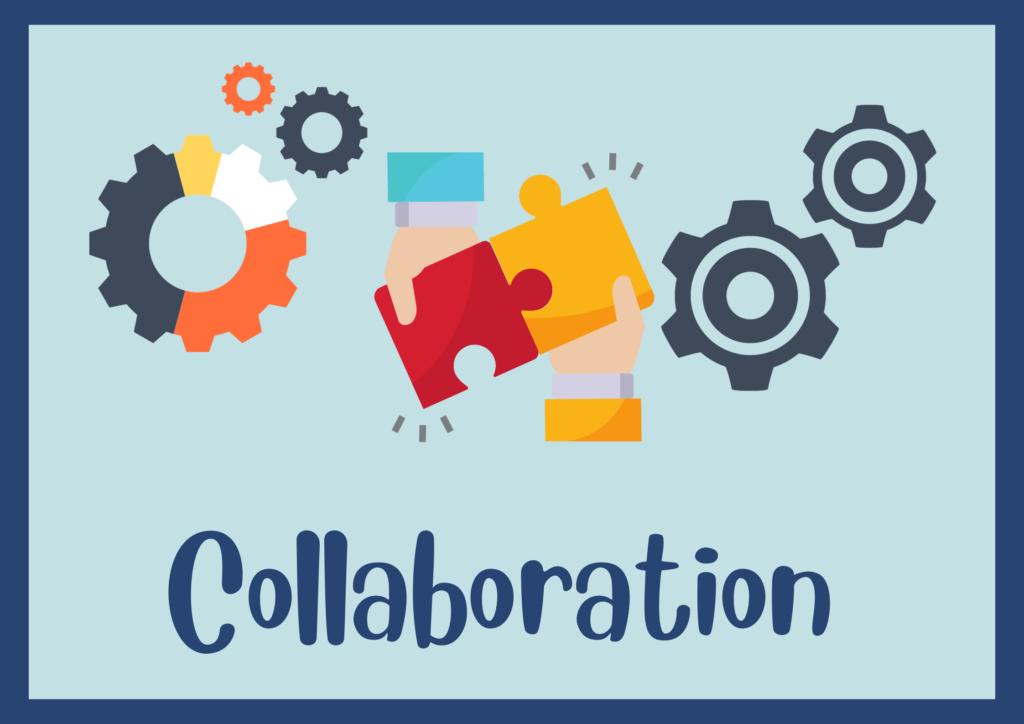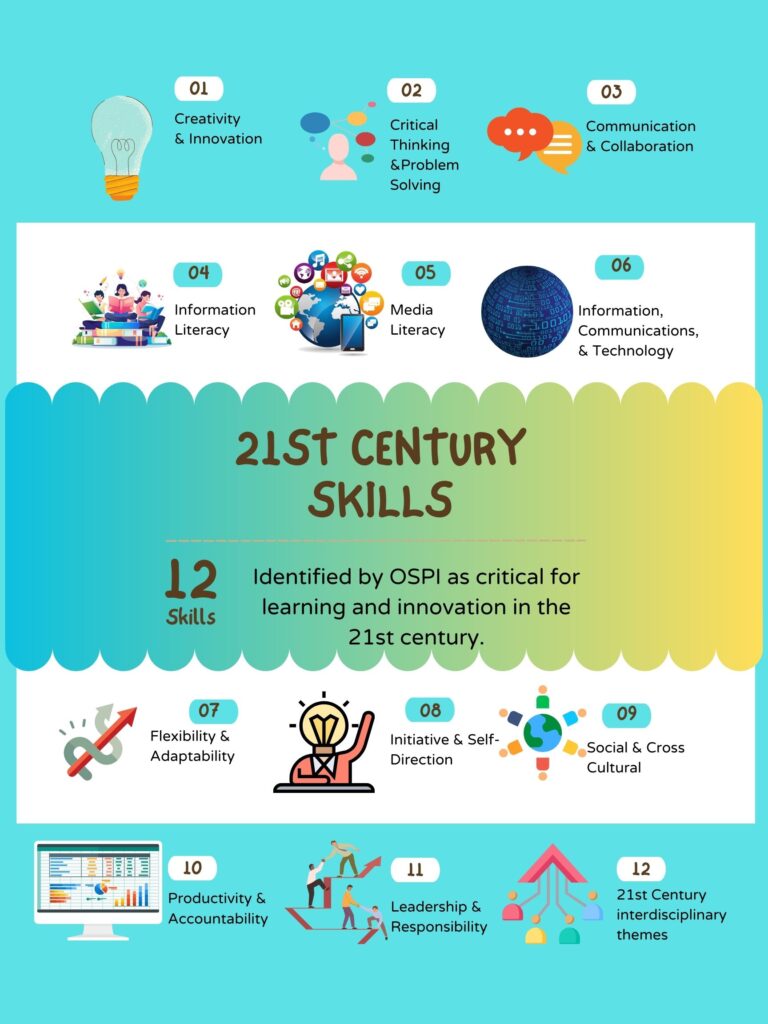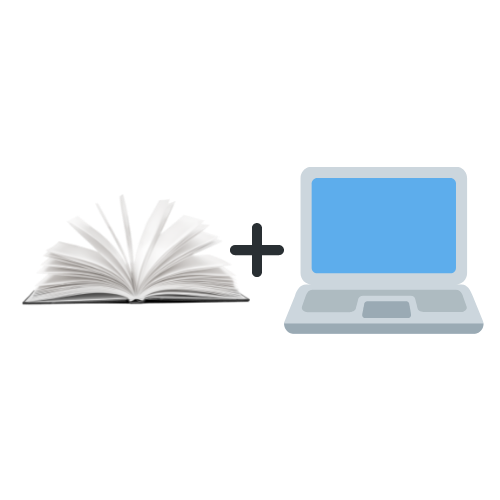
For module 3 I decided to focus on ISTE Coaching Standard 4: Learning Designer: “Coaches model and support educators to design learning experiences and environments to meet the needs and interests of all students” (ISTE, n.d.). As well as ISTE Coaching Standard 3: Collaborator 4.3a: cultivate coaching relationships, 4.3b: identify relevant learning content with educators, 4.3c: evaluate effectiveness of tools for learning, and 4.3d: personalize support for educators (ISTE, n.d.).
My question morphed throughout my research and became: building on the theme of trust and reluctance, now that you have built a relationship and convinced a reluctant teacher to try something new, what are the best coaching collaboration tools and how can these collaboration tools be used within the classroom to teach 21st century skills to students?
The first thing that I needed to do was establish exactly what 21st century skills are. As a Washington state teacher, I went to the Washington Office of Superintendent of Public Instruction and found the website for 21st Century Skills. OSPI has developed a framework of 12 skills broken into multiple observable to micro skills. See the graphic I have designed below to represent the 12 skills that the state has identified (Instruction, n.d.).

The next thing I needed to do was figure out how EdTech coaches can identify collaboration tools that will work with instructors that have been previously reluctant to utilize technology in their classrooms, and how can these same collaboration tools be used to teach 21st century skills?
EdTechHub (n.d.) had some amazing suggestions when working with teachers who are may be less comfortable with technology. They suggest working with tools that the teachers are already comfortable with. This also means that you may have to personalize your coaching tools for each teacher you work with. Another suggestion from EdTechHub (n.d.) is to make sure that whatever tool you pick is appropriate to the teachers digital skill level.
As a teacher with multiple years of experience, the best way I have found to teach a skill to my students is to model that skill. For instance, the best way to teach the 21st century skill of collaboration to my students, would be to model that skill, and what to model it that by working with another teacher. This can be done by team teaching the teacher you are coaching. Alsarawi (2019) recommends co-teaching as part of the coaching process. This is an excellent way to model collaboration and communication to your students.
Another way that EdTech coaches can begin the collaboration process with teachers is to utilize tools like surveys. Apple Inc. (2022) suggested utilizing surveys throughout their Apple Coaching training when working with teachers in their coaching journey. Surveys are a great way to learn what teachers are looking for from an EdTeach Coach. Surveys are also a great opportunity to find out what technology a teacher is already comfortable with using and what technology a teacher is unfamiliar with. McBride (2021) suggests using surveys at the end of coaching cycles to find out how training went for a teacher and to gather feedback. Once you have identified a teacher’s comfort level with different types of collaborative tools, you are now ready to begin the work of collaborating and tracking your projects electronically.
There are many great tools that came up for collaboration between EdTech coaches and teachers, some that are free of charge and some that come at a price. Geeks of Gurukul (2023, May 30) had suggestions for multiple collaboration tools that could be used for both students and teacher collaboration, here are a mixture of the ones from Geeks of Gurukul and EdTech Hub, as well as a couple of others that I thought would be most helpful for EdTech Coaches and teachers. Here is a rundown of what I found and the costs associated with them as of October 2023:
| Tool | Cost |
| Google Tools | Free to a certain point |
| Microsoft Teams | Subscription required |
| Padlet | 3 free padlets, then subscription required |
| Trello | Free to a point, subscription and up costs get you more |
| Lucidspark | Free to a point, subscription and up costs get you more |
The most important thing to remember is that any tool that you are going to use with students, you need to first make sure it goes through your IT department and through any vetting required by your school district. It is important to stay in compliance with these rules to keep yourself and the person you are coaching covered.
Alsarawi, A. (2019). A process, framework, and set of tools for facilitating co-planning among co-teachers. International Journal of Whole Schooling, 15(2), 1-23. https://eric.ed.gov/?id=EJ1218543
AppleInc. (2022). Coaching Journal Unit 1. Apple Inc. https://education.apple.com/en
Dunworth, M. (2023a). Collaboration.
Dunworth, M. (2023b). 21st Century Skills.
EdTechHub. (n.d.). Tools for communication and collaboration. EdTech Hub. https://edtechhub.org/edtech-tools/curated-tools-tcpd/communication-and-collaboration/
Gurukul, G. o. (2023, May 30). EdTech tools for classroom collaboration. LinkedIn. https://www.linkedin.com/pulse/edtech-tools-classroom-collaboration-geeks-of-gurukul/
Instruction, W. O. o. S. o. P. (n.d.). 21st Century Skills. Washington Office of Superintendent of Public Instruction. https://ospi.k12.wa.us/student-success/career-technical-education-cte/cte-resources-essentials/21st-century-skills
ISTE. (n.d.). ISTE Standards: Coaches. International Society for Technology in Education. https://www.iste.org/standards/iste-standards-for-coaches
McBride, A. (2021). The Edtech Coaching Primer : Supporting Teachers in the Digital Age Classroom. International Society for Technology in Education. http://ebookcentral.proquest.com/lib/spu/detail.action?docID=6683479

4 replies on “Communicate to Collaborate”
I agree that the best way to teach 21st-century skills to students is by modeling the skills and showing how collaboration is done by co-teaching with another teacher. I especially like your graphic artwork on the image with OSPI 21st-century skills. Great work!
Thank you! I love designing the graphics, they help me to really visualize everything.
Great post! I love how you emphasize the importance of communication in collaboration. It truly is key to successful teamwork. Well done!
Thanks Abdulelah. If we forget the importance of communication, then collaboration never stands a chance. I appreciate your feedback.